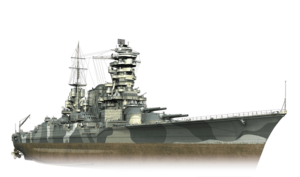Tipparavai-class aircraft carrier

| |
| Class overview | |
|---|---|
| Name: | Anginda class |
| Operators: |
|
| Planned: | 2 |
| Completed: | 2 |
| General characteristics 1935 | |
| Type: | Aircraft carrier |
| Displacement: | |
| Length: | 250 m (820 ft 3 in) |
| Beam: | 32.7 m (107 ft 3 in) |
| Draft: | 9.8 m (32 ft 2 in) |
| Installed power: | |
| Propulsion: | 4 × shafts; 4 × geared steam turbines |
| Speed: | 30 knots (56 km/h; 35 mph) |
| Range: | 8,000 nmi (15,000 km; 9,200 mi) at 15 knots (28 km/h; 17 mph) |
| Armament: |
|
| Armor: |
|
| Aircraft carried: |
|
The Tipparavai-class was a class of aircraft carriers built for the Royal Tennaiite Navy and was named after the firebird of Tennaiite mythology. Originally intended to be two ships of the Anginda-class battleship, thier design was converted due to the percieved need for new carriers quickly while design work continued on the Naka-class carriers. The shapes were given the names RK Tipparavai and RK Karutan.
These ships figured prominently in the development of the RTN's carrier striking force doctrine, which created battlegroups centered around one or more carriers. A revolutionary strategic concept at the time, the employment of the doctrine was important in enabling Tennai to attain its strategic goals during the naval theatre of the Siduri War.
The ships' first major engagement was during the Battle of the Sabri Sea, in which poor weather and the chaotic nature of the engagement meant that the ships could not be fully utilized for thier intended role. Nonetheless,the RK Tipparavai and RK Karutan's aircraft were still able to damage Syaran vessels during the course of the battle.
Following minor repairs following the battle, both the RK Tipparavai and RK Karutan were redeployed and continued to serve throughout the rest of the Siduri War.